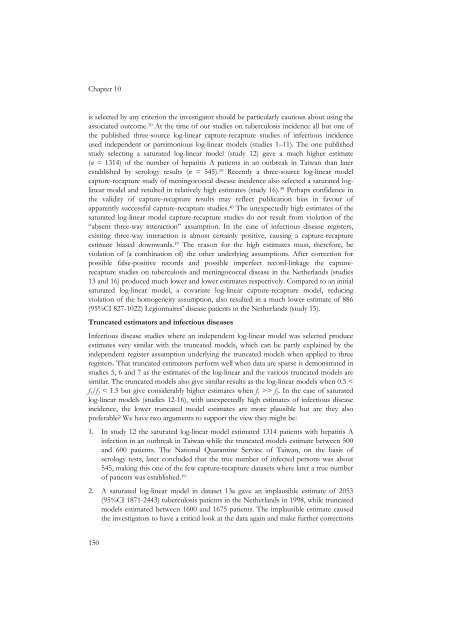Rob van Hest Capture-recapture Methods in Surveillance - RePub ...
Rob van Hest Capture-recapture Methods in Surveillance - RePub ...
Rob van Hest Capture-recapture Methods in Surveillance - RePub ...
You also want an ePaper? Increase the reach of your titles
YUMPU automatically turns print PDFs into web optimized ePapers that Google loves.
Chapter 10<br />
is selected by any criterion the <strong>in</strong>vestigator should be particularly cautious about us<strong>in</strong>g the<br />
associated outcome. 10 At the time of our studies on tuberculosis <strong>in</strong>cidence all but one of<br />
the published three-source log-l<strong>in</strong>ear capture-<strong>recapture</strong> studies of <strong>in</strong>fectious <strong>in</strong>cidence<br />
used <strong>in</strong>dependent or parsimonious log-l<strong>in</strong>ear models (studies 1–11). The one published<br />
study select<strong>in</strong>g a saturated log-l<strong>in</strong>ear model (study 12) gave a much higher estimate<br />
(n = 1314) of the number of hepatitis A patients <strong>in</strong> an outbreak <strong>in</strong> Taiwan than later<br />
established by serology results (n = 545). 19 Recently a three-source log-l<strong>in</strong>ear model<br />
capture-<strong>recapture</strong> study of men<strong>in</strong>gococcal disease <strong>in</strong>cidence also selected a saturated logl<strong>in</strong>ear<br />
model and resulted <strong>in</strong> relatively high estimates (study 16). 39 Perhaps confidence <strong>in</strong><br />
the validity of capture-<strong>recapture</strong> results may reflect publication bias <strong>in</strong> favour of<br />
apparently successful capture-<strong>recapture</strong> studies. 40 The unexpectedly high estimates of the<br />
saturated log-l<strong>in</strong>ear model capture-<strong>recapture</strong> studies do not result from violation of the<br />
“absent three-way <strong>in</strong>teraction” assumption. In the case of <strong>in</strong>fectious disease registers,<br />
exist<strong>in</strong>g three-way <strong>in</strong>teraction is almost certa<strong>in</strong>ly positive, caus<strong>in</strong>g a capture-<strong>recapture</strong><br />
estimate biased downwards. 39 The reason for the high estimates must, therefore, be<br />
violation of (a comb<strong>in</strong>ation of) the other underly<strong>in</strong>g assumptions. After correction for<br />
possible false-positive records and possible imperfect record-l<strong>in</strong>kage the capture<strong>recapture</strong><br />
studies on tuberculosis and men<strong>in</strong>gococcal disease <strong>in</strong> the Netherlands (studies<br />
13 and 16) produced much lower and lower estimates respectively. Compared to an <strong>in</strong>itial<br />
saturated log-l<strong>in</strong>ear model, a covariate log-l<strong>in</strong>ear capture-<strong>recapture</strong> model, reduc<strong>in</strong>g<br />
violation of the homogeneity assumption, also resulted <strong>in</strong> a much lower estimate of 886<br />
(95%CI 827-1022) Legionnaires' disease patients <strong>in</strong> the Netherlands (study 15).<br />
Truncated estimators and <strong>in</strong>fectious diseases<br />
Infectious disease studies where an <strong>in</strong>dependent log-l<strong>in</strong>ear model was selected produce<br />
estimates very similar with the truncated models, which can be partly expla<strong>in</strong>ed by the<br />
<strong>in</strong>dependent register assumption underly<strong>in</strong>g the truncated models when applied to three<br />
registers. That truncated estimators perform well when data are sparse is demonstrated <strong>in</strong><br />
studies 5, 6 and 7 as the estimates of the log-l<strong>in</strong>ear and the various truncated models are<br />
similar. The truncated models also give similar results as the log-l<strong>in</strong>ear models when 0.5 <<br />
f1/f2 < 1.5 but give considerably higher estimates when f1 >> f2. In the case of saturated<br />
log-l<strong>in</strong>ear models (studies 12-16), with unexpectedly high estimates of <strong>in</strong>fectious disease<br />
<strong>in</strong>cidence, the lower truncated model estimates are more plausible but are they also<br />
preferable? We have two arguments to support the view they might be:<br />
1. In study 12 the saturated log-l<strong>in</strong>ear model estimated 1314 patients with hepatitis A<br />
<strong>in</strong>fection <strong>in</strong> an outbreak <strong>in</strong> Taiwan while the truncated models estimate between 500<br />
and 600 patients. The National Quarant<strong>in</strong>e Service of Taiwan, on the basis of<br />
serology tests, later concluded that the true number of <strong>in</strong>fected persons was about<br />
545, mak<strong>in</strong>g this one of the few capture-<strong>recapture</strong> datasets where later a true number<br />
of patients was established. 19<br />
2. A saturated log-l<strong>in</strong>ear model <strong>in</strong> dataset 13a gave an implausible estimate of 2053<br />
(95%CI 1871-2443) tuberculosis patients <strong>in</strong> the Netherlands <strong>in</strong> 1998, while truncated<br />
models estimated between 1600 and 1675 patients. The implausible estimate caused<br />
the <strong>in</strong>vestigators to have a critical look at the data aga<strong>in</strong> and make further corrections<br />
150

















